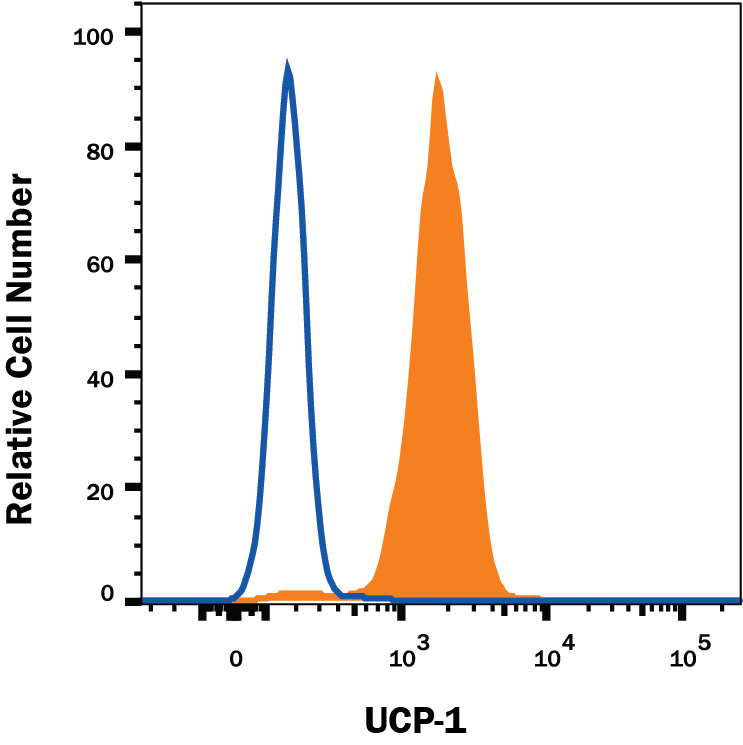Human/Mouse UCP1 PE-conjugated Antibody Summary
Met1-Thr307
Accession # P25874
Applications
Please Note: Optimal dilutions should be determined by each laboratory for each application. General Protocols are available in the Technical Information section on our website.
Scientific Data
 View Larger
View Larger
Detection of UCP1 in Human Preadipocytes by Flow Cytometry. Human preadipocytes were stained with Mouse Anti-Human/Mouse UCP1 PE-conjugated Monoclonal Antibody (Catalog # IC6158P, filled histogram) or isotype control antibody (Catalog # IC0041P, open histogram). To facilitate intracellular staining, cells were fixed with Flow Cytometry Fixation Buffer (Catalog # FC004) and permeabilized with Flow Cytometry Permeabilization/Wash Buffer I (Catalog # FC005). View our protocol for Staining Intracellular Molecules.
 View Larger
View Larger
Detection of UCP1 in 3T3‑L1 Mouse Cell Line by Flow Cytometry. 3T3-L1 mouse embryonic fibroblast adipose-like cell line was stained with Mouse Anti-Human/Mouse UCP1 PE-conjugated Monoclonal Antibody (Catalog # IC6158P, filled histogram) or isotype control antibody (Catalog # IC0041P, open histogram). To facilitate intracellular staining, cells were fixed with Flow Cytometry Fixation Buffer (Catalog # FC004) and permeabilized with Flow Cytometry Permeabilization/Wash Buffer I (Catalog # FC005). View our protocol for Staining Intracellular Molecules.
Reconstitution Calculator
Preparation and Storage
- 12 months from date of receipt, 2 to 8 °C as supplied.
Background: UCP1
Mitochondrial brown fat uncoupling protein 1 (UCP1; also Thermogenin and UCP) is a 33 kDa member of the mitochondrial carrier family of proteins. Human and mouse UCP1 are both 307 amino acids (aa) in length and contain three solcar repetitive regions and six transmembrane segments. UCP1 is found in brown adipose tissue, where it becomes activated by fatty acids and inhibited by nucleotides. It functions as a mitochondrial transporter that creates a proton leak across the inner mitochondrial membrane, uncoupling oxidative phosphorylation from ATP synthesis. As a result, energy is dissipated in the form of heat. Human and mouse UCP1 share 79% aa sequence identity.
Product Datasheets
Citation for Human/Mouse UCP1 PE-conjugated Antibody
R&D Systems personnel manually curate a database that contains references using R&D Systems products. The data collected includes not only links to publications in PubMed, but also provides information about sample types, species, and experimental conditions.
1 Citation: Showing 1 - 1
-
Generation of Functional Brown Adipocytes from Human Pluripotent Stem Cells via Progression through a Paraxial Mesoderm State
Authors: L Zhang, J Avery, A Yin, AM Singh, TS Cliff, H Yin, S Dalton
Cell Stem Cell, 2020-08-11;0(0):.
Species: Human, Xenograft
Sample Types: Cell Lysates, Whole Cells, Whole Tissue
Applications: Flow Cytometry, ICC, IHC, Western Blot
FAQs
No product specific FAQs exist for this product, however you may
View all Antibody FAQsReviews for Human/Mouse UCP1 PE-conjugated Antibody
There are currently no reviews for this product. Be the first to review Human/Mouse UCP1 PE-conjugated Antibody and earn rewards!
Have you used Human/Mouse UCP1 PE-conjugated Antibody?
Submit a review and receive an Amazon gift card.
$25/€18/£15/$25CAN/¥75 Yuan/¥2500 Yen for a review with an image
$10/€7/£6/$10 CAD/¥70 Yuan/¥1110 Yen for a review without an image


